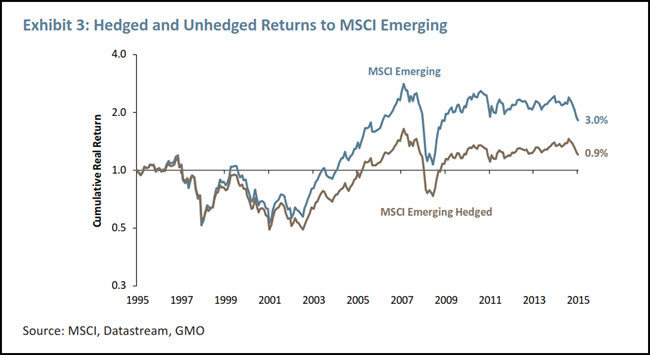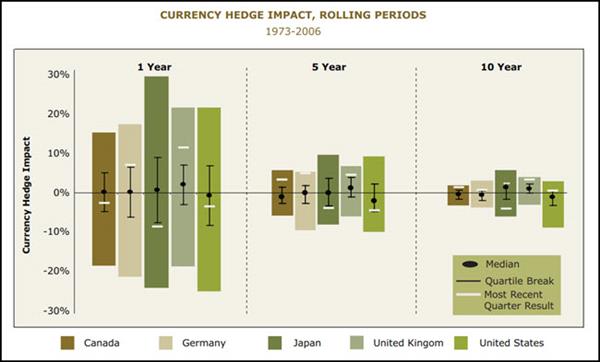Should you hedge currency risk in your stock portfolio?
This is a good question I have given a lot of thought and done a lot of research on. Here are my best ideas.
What is a currency hedging?
What is currency hedging?
If you have a portfolio with foreign companies (Japanese stocks for example) your portfolio will be currency hedged if you have an equal opposite investment in the currency (a loan in Japanese Yen, for example).
This is easier to understand with am example.
How does hedging work?
To hedge a currency you have to borrow the foreign currency and invest that in the foreign stock.
Here is an example.
Say the currency where you live is Euro and you want to invest in Japan.
But you do not want to sell Euros and buy Japanese Yen because you are worried that the Yen will fall against the Euro and give you a currency loss when you sell the stock and convert the Yen proceeds back to Euro.
To not have any Yen risk you have to borrow Yen and buy the shares in Japan.
When you sell the Japanese shares you use the money to repay the Yen you borrowed and only the profit or loss is converted to Euro. If you have a loss the proceeds will not be enough to repay the Yen loan, you will then have to sell Euro and buy Yen to completely pay back the loan.
Remember you will ALWAYS have currency risk on your profit or loss as you only hedged (borrowed Yen) for the capital you invested.
Click here to find companies that EXACTLY fit your investment strategy
But you have to pay interest
But when you borrow you have to pay interest.
You borrow Yen and have to pay interest on this loan. Some brokers allow you to do this easily but they charge a lot for these loans.
And you have to pledge your portfolio to your broker as security for the loan - your broker needs this security to make sure your loan is repaid.
Even if Yen interest rates are low, if your broker charges 2% per year - if you hold the investment for 3 years – the loan will cost you 6%.
That is expensive!
What does the research say?
I looked for research on currency hedging and found two interesting research papers.
#1 When hedging currency was a bad idea
In the third quarter of 2015 GMO (www.gmo.com) published an interesting quarterly report called: Just How Bad Is Emerging, and How Good Is the U.S.? and Give Me Only Good News!
In the report they looked at the US Dollar hedged and un-hedged returns of emerging markets stocks over the 20 year period from 1995 to 2015.
In the report they wrote:
Is it just a currency thing?
Falling currencies have indeed been a significant driver of losses in emerging equities over the past few years. In the 12 months ending September 30, for example, the local return to emerging stocks was -7.1% while the loss from the currency movements cost 13.1%. This might tempt one to think about currency hedging their holdings in emerging markets, but this turns out to be a bad idea historically.
In fact, it seems to be a spectacularly bad idea, as we can see in Exhibit 3.

Source: www.gmo.com Just How Bad Is Emerging, and How Good Is the U.S.? and Give Me Only Good News!
This is a truly striking chart. Since 1995, the rather anemic returns of +3.0% real in U.S. dollars for emerging equities turn into a truly depressing +0.9% real. So much for the idea of currency hedging!
So for emerging markets hedging is a bad idea
So if you invested in emerging markets hedging currency risk was a bad idea over the 20 year period from 1995 to 2015.
#2 If you want to hedge do it all the time - ignore recent movements
In 2007 The Brandes Institute, part of the respected value fund manager Brandes Investment Partners published a research paper called: Currency Hedging Programs: The Long-Term Perspective.
In the paper they looked at 34 years of data to find out if currency hedging is worth it.
The results are summarised in the following chart which shows the benefit or loss to your portfolio if you hedged currency risk:
Source: Brandes Institute - Currency Hedging Programs: The Long-Term Perspective
What does the chart tell you?
What can you learn from the chart?
1. The most recent currency movement is a bad predictor of future movements.
This is especially true in times of wild currency movements. You can see this if you look at the small horizontal white line (Most Recent Quarter Result) in the chart. In nearly every time period it is at an extreme level compared to the median value in each bar.
This means if you only look at the most recent currency movement (last quarter in the chart) to decide to hedge or not you may be making a big mistake as the next movement may be in the other direction.
2. Currency movements are big over one year periods and remain large over five and even 10 years. This means you must be prepared for long periods of hedging losses or gains, or if you do not hedge, some big currency movement profits or losses.
3. Your base currency matters as some currencies are more volatile than others.
4. Hedging can make a difference if you plan to invest for less than five years. After that hedging gains and losses get smaller but they do not disappear.
For example a US based investor that hedged currency risk over the 34 year period would have had an average annualised loss of 1.8%.
That is a huge drag on performance but it could just as well have been a profit. The thing is you just don’t know.
Click here to find companies that EXACTLY fit your investment strategy
In summary
What can we learn from the research?
- Hedging emerging market currency risk was a bad idea over the 20 year test period. Will this be any better in the future? – We simply do not know and if some expert says he does he is lying – no one knows!
- Hedging currency risk of developed countries can give you a slight positive or negative return over 10 years, a lot larger gains or losses over 5 years and even more so over one year. If you want to avoid all currency profits or losses you must follow a strict hedging strategy and stick to it.
- What both studies mentioned is that there is a huge behavioural risk that comes with currency movements.
- The risk is that you may want to predict future currency movements based on the most recent past, think 1 to 3 years, especially if you have just had large currency losses.
- The recent loss may cause you to hedge your currency risk just as the currency turns around, resulting in your hedges giving you large currency losses.
What I do with my portfolio
I have been investing world-wide for over 30 years and have never hedged currencies.
This is because:
- It’s expensive
- The part of my portfolio invested in different currencies being relatively small and
- It makes investing even more difficult because you also have to manage currency hedges
- Over long periods of time currency movements net out to close to zero
So, I do not hedge currency movements.
Keep it simple
Like you I want to keep investing as simple and systematic as possible. Hedging currency risk is not something I want to do if over time it is most likely to only increase or decrease your investment returns by a small percentage.
If you want to hedge currency risk – do this
You may have a different view on hedging currency risk and you may be right.
If you do you must make a conscious decision and stick to it – this means hedge all the time. If not you will most likely start hedging after a large currency loss, just as the currency turns around.
PS Would you like to get market beating investment ideas delivered to your inbox every month? Is so find out more here: Get Investment Ideas from Only the Best Strategies
PPS It is so easy to put things off, why not sign up right now?
Click here to find companies that EXACTLY fit your investment strategy



